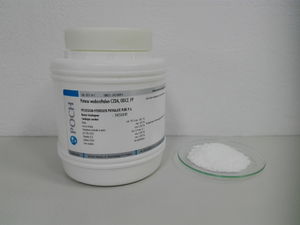Potassium hydrogen phthalate
 Potassium hydrogen phthalate sample
| |
| Names | |
|---|---|
| IUPAC name
Potassium hydrogen phthalate
| |
| Other names
1,2-Benzenedicarboxylic acid
Hydrogen potassium phthalate KHP KHPh Monopotassium phthalate Phthalic acid potassium salt Potassium acid phthalate Potassium biphthalate Potassium biphthalate monopotassium salt | |
| Properties | |
| C8H5KO4 | |
| Molar mass | 204.22 g/mol |
| Appearance | White solid |
| Odor | Odorless |
| Density | 1.636 g/cm3 |
| Melting point | 295–300 °C (563–572 °F; 568–573 K) (decomposes) |
| Boiling point | Decomposes |
| 8 g/100 ml (20 °C) | |
| Solubility | Slightly soluble in ethanol, methanol Insoluble in hydrocarbons, halocarbons |
| Vapor pressure | ~0 mmHg |
| Hazards | |
| Safety data sheet | Sigma-Aldrich |
| Flash point | Non-flammable |
| Lethal dose or concentration (LD, LC): | |
| LD50 (Median dose)
|
3,200 mg/kg (rat, oral) |
| Related compounds | |
| Related compounds
|
Phthalic acid Phthalic anhydride |
| Except where otherwise noted, data are given for materials in their standard state (at 25 °C [77 °F], 100 kPa). | |
| Infobox references | |
Potassium hydrogen phthalate or potassium biphthalate, often called simply KHP, is an acidic salt of phthalic acid. KHP has the chemical formula C8H5KO4.
Contents
Properties
Chemical
Potassium hydrogen phthalate is neutralized completely with potassium hydroxide or carbonate to dipotassium phthalate.
Physical
Potassium hydrogen phthalate is a colorless crystalline solid, moderate soluble in water. It is stable in air and is not hygroscopic.
Availability
Potassium hydrogen phthalate is sold by chemical suppliers.
Preparation
Can be prepared by partially neutralizing phthalic acid with potassium hydroxide or potassium bicarbonate.
Projects
- Standard in acid-base titrations and thermogravimetric analysis
- Buffering agent
- Preparation of phthalic acid and phthalic anhydride
Handling
Safety
Potassium hydrogen phthalate is irritant and should be handled with care.
Storage
In closed bottles.
Disposal
No special disposal is required, though it's best to neutralize it completely before disposal. It can be destroyed by using a hot oxidizing solution.